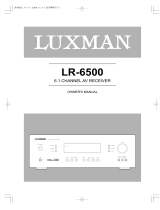
NAMES AND
FUNCTIONS
2
BASIC
CONNECTIONS
BASIC
OPERATION
ADVANCED
CONNECTIONS
SETUP
ADVANCED
OPERATION
TROUBLESHOOTING
OTHERS
ENGLISH
FEATURES
HD AUDIO DECODER FEATURED
This unit comes with the latest digital surround
sound decoding technologies listed below. For
further details, refer to “SURROUND MODE”
(page 40).
• Dolby True HD
• Dolby Digital Plus
• Dolby Digital, Dolby Digital EX
• DTS-HD (Master Audio, Hi-Resolution Audio)
• DTS, DTS ES, DTS Neo:6, DTS 96/24
• Dolby Pro-Logic II x
AUTO SETUP SYSTEM
The unit has been provided with an auto setup
function that uses a high-performance DSP (digital
signal processor) to analyze the data obtained by
measuring the characteristics of the speakers and
the characteristics of the listening room using
the high-performance microphone supplied and
which, based on the results of this analysis and
arithmetic calculation processing, compensates
the frequency characteristics in such a way that
the entire listening room becomes the optimum
listening environment.
7-CHANNEL DISCRETE AMPLIFIER
A 7-channel discrete amplifier boasting a wide
range over which it exhibits the same high-level
performance is employed.
HDMI TERMINALS INCORPORATED
Incorporating an IC for HDMI (High-Definition
Multimedia Interface) that is compatible with HDMI
Ver1.3a, which is the most up-to-date version,
makes it possible for the HDMI terminals to support
the transmission of video signals compliant with
the Deep Color and x.v.Color standards, while at the
same time enabling them to support Dolby TrueHD,
DTS-HD and Dolby Digital Plus used with Blu-ray
discs and HD DVDs.
VIDEO CONVERTER FEATURED
The unit has an up-converter (that converts composite
and component signals into HDMI signals) for the
video signals using full digital processing.
WIDE-BAND COMPONENT VIDEO
SELECTOR
Three input lines and one output line for the
component video signals are featured. High-
defi nition and other wide-band (80 MHz (-3 dB))
video signals are supported.
SLIM-LINE DESIGN FOR GREATER
FREEDOM OF INSTALLATION
By endowing this unit with slim dimensions for a
multi-channel AV receiver, users can even install it
where space is at a premium.
OTHER FEATURES
• 32-bit latest DSP
• OSD (on-screen display) menu system enabling
the settings to be selected on the TV screen
• Remote controller with preset functions
• Environmentally friendly low-power-consumption
STANDBY mode
• Cursor buttons provided on the front panel
• AUX1 input terminals enabling a digital audio
player or other component to be connected using
3.5 mm φ stereo mini jacks provided on the front
panel
EQUIPMENT MAINS WORKING
SETTING
Your Marantz product has been prepared to comply
with the household power and safety requirements
that exist in your area.
This unit can be powered by 120V AC only.
DO NOT LOCATE IN THE
FOLLOWING PLACES
To ensure long-lasting use, do not locate the unit
where:
• Exposed to direct sunlight.
• Near to sources of heat such as heaters.
• Highly humid or poorly ventilated.
• Dusty.
• Subjected to mechanical vibrations.
• On wobbly, inclined or otherwise unstable
surfaces
• Near windows where there is a chance of
exposure to rain, etc.
• On top of an amplifi er or other component which
dissipates a great deal of heat
To ensure proper heat radiation, ensure the below
clearance from walls and other equipment.
Left 0.2 m (8 in)
or more
Right 0.2 m (8 in)
or more
Above 0.2 m (8 in)
or more
Rear 0.2 m (8 in) or more
KEEP OBJECTS OFF
Keep objects off the unit. Blocking the vent can
result in accident and damage.
BEFORE USE




















